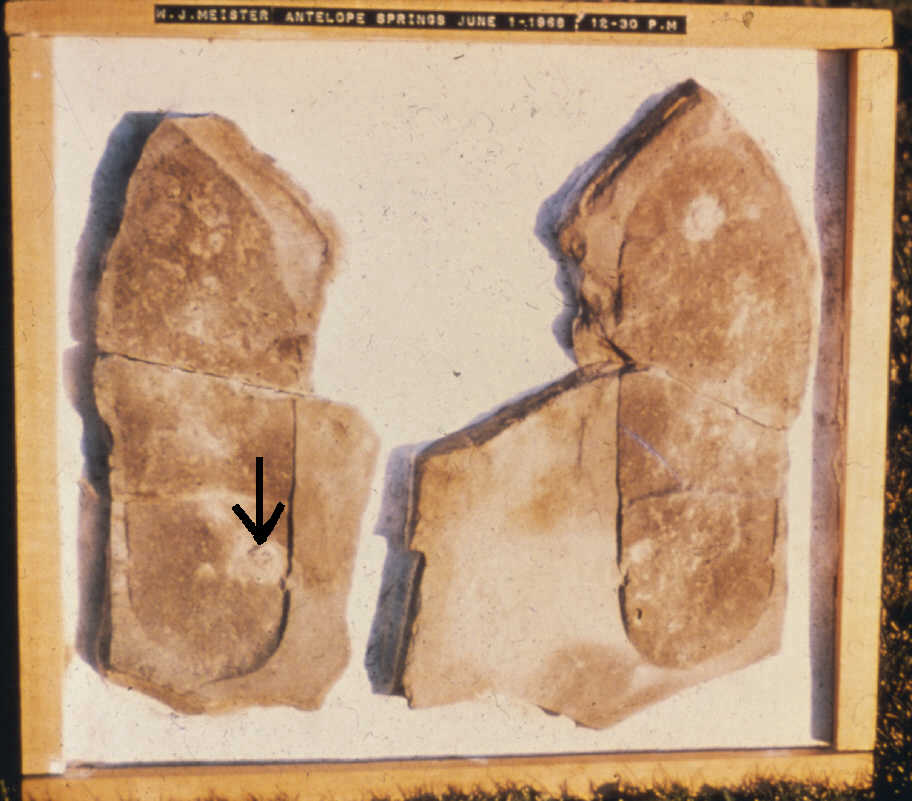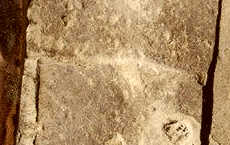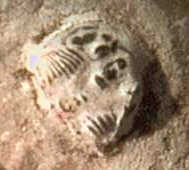


© Glen J. Kuban, 1998 - 2011
Part of Kuban's Paluxy web site
According to Dr. Melvin Cook (1970), a local rockhound named William J. Meister was hunting for trilobite fossils along a hillside near Antelope Springs, Utah in 1968 when he broke open a slab and discovered a curious oblong marking that he took for a human sandal print. This was quite surprising, since the rock at this locality is identified as the middle Cambrian Wheeler Formation--over 500 million years old.
The supposed print measured approximately 10 1/2 inches by 3 1/2 inches, and occurred on both sides of the slab (with opposite relief). The specimen included what Meister took as a heel demarcation, as well as at least two small trilobites (extinct, superficially crab-like arthropods).

| 
| 
|
| The "Meister Print". Photo provided by Clifford Burdick, 1982. Arrow points to one of the trilobites in the specimen. | Close-up of the "heel" line of the specimen, showing the crack line extending beyond the indentation on the left side of the specimen. | Close-up of the better preserved trilobite in the specimen. |
The specimen does contain at least two real trilobites (which are abundant in the outcrops around Antelope Springs), but the supposed sandal print does not stand up to close scrutiny. The overall shape is seen to consist of a spall pattern in a concretion-like slab, similar to many others in the area. There is no evidence that it was ever part of a striding sequence, nor that it was ever on an exposed bedding plane, as real prints would be. The "print" is very shallow and shows no sign of pressure deformation or foot movement at its margin. However, on one side of the print, extending to the side of the supposed toe end is a rim or lip that is typical of similar concretions from the area, but which is incompatible in position and form to be a pressure ridge. Also, of the two halves of rock, the side that has the heel indented shows raised relief at the toe end, and vice versa, whereas in a real print one should show impression or raised relief throughout each half.
The supposed "heel" demarcation is actually a crack that runs beyond the boundary of the supposed print. It is best seen on the far left side as one views the print in the photograph herein. The slight relief difference at this point is due to slight movement along the crack line (Conrad, 1981 ; Stokes, 1986).
Similar concretionary shapes and spall patterns are abundant in the Wheeler formation, as are slabs showing concentric oval shapes of varying color, sometimes with stair-step like relief. Several other of these oblong features have also been interpreted as possible human prints (Cook, 1970), but are even less convincing than the Meister specimen (Conrad, 1981). None occur in striding trails or otherwise meet the scientific criteria by which genuine human prints are reliably identified. The geochemical processes such as solution penetrations, spalling, and weathering which form such features in fissile rocks of the Wheeler formation was discussed in considerable detail by Stokes (1986).
Several such "pseudo-prints" from Antelope Springs were sent to me in the early 1980's by creationist biologist Ernest Booth. One showed both an ovoid spall pattern similar to the Meister print, and another a color-distinct ovoid pattern without topographic relief. Booth expressed dismay that fellow creationists had not explained that such superficially print-like features were abundant at the site, and were products of geological phenomena and not real prints (Booth, 1982).
Some creationists have noted that the find was "confirmed" by "Dr. Cook." However, Dr. Cook was a metallurgist with little paleontological experience or knowledge. In his own report on the find Cook states, "...I am by no means an authority on fossils and footprints." He adds that the print seems to "speak for itself". However, upon careful inspection the evidence does not support Cook's conclusions.
In short, the trilobites in the specimen are real enough, but the "print" itself appears to be due solely to inorganic, geologic phenomena. After mainstream rebuttals of this find were published in the 1980's (Conrad, 1981; Stokes, 1986; Strahler, 1987), only a few creationists continued to suggest this was a real print, while most fromer advocates of the specimen have quietly abandoned the case.
References cited
Booth, Ernest S. 1982 (Dec. 30). Personal correspondence to Glen Kuban.
Cook, Melvin A. 1970. "William J. Meister Discovery of Human Footprints with Trilobites in a Cambrian Formation of Western Utah." In Why Not Creation? ed. by Walter E. Lammerts. Philadelphia: Presbyterian and Reformed Publishing Company. pp. 186-193.
Baker, Sylvia. 1976. Bone of Contention. Grand Rapids, MI: Evangelical Press. pp. 8-9.
Conrad, Ernest C. 1981. "Tripping Over a Trilobite," Creation/Evolution Issue VI , pp. 30-33.
Huse, Scott M. 1983. The Collapse of Evolution. Grand Rapids, MI: Baker Book House. p. 17.
Kofahl, Robert E. and Kelly L. Segraves. 1975. The Creation Explanation. Wheaton, IL: Harold Shaw Publishers. p. 54.
Petersen, Dennis R. 1987. Unlocking the Mysteries of Creation El Cajon, Ca.: Master Books. p. 93.
Stokes, William Lee. 1986. "Alleged Human Footprint from the Middle Cambrian Strata, Millard County, Utah." Journal of Geologic Education Vol. 34, pp. 187-90.
Strahler, Arthur N. 1987. Science and Earth History Buffalo, New York: Prometheus Books. pp. 459-461.
Voss, Jr. Charles H. 1993. Did God Direct Evolution? Baton Rouge, LA: Radio Bible Course.
File: Meister.htm
Rev. June, 2005, GJK, Added photos of trilobite and heel close-up.
Rev. Feb. 9, 1998, GJK
Rev. Jan. 2001, GJK, Fixed typo (1986 corrected to 1968 near start of paper).